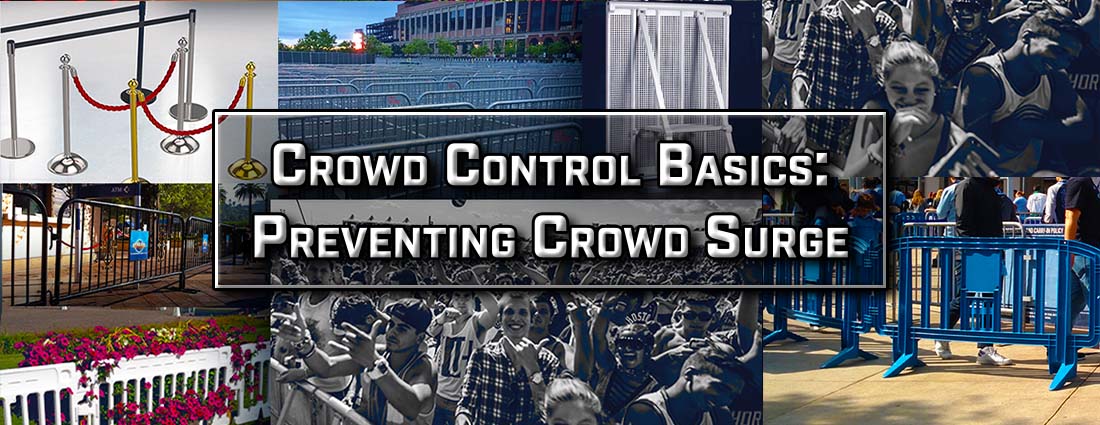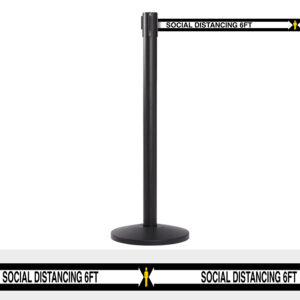
Crowd Control Basics: Preventing Crowd Surge
- Introduction to Crowd Control Basics
- Understanding Crowd Surges
- The Role of Safety Protocols and Emergency Preparedness
- Utilizing Appropriate Crowd Control Measures
- Benefits and Best Practices
- Training and Staffing for Effective Crowd Control and Management
- Ensuring Public Safety Communication
- Conclusion to Crowd Control Basics
Introduction to Crowd Control Basics
A crowd surge occurs when a large group of people moves chaotically, often leading to dangerous situations. Addressing crowd surges is crucial in event management to ensure the safety of attendees and prevent potential disasters. Crowd surges can result from numerous factors, including overcrowding, lack of communication, or heightened emotions during an event.
Uncontrolled crowds present significant risks:
- Physical injuries due to trampling or crushing.
- Emotional distress and panic among attendees.
- Logistical challenges in managing emergency responses.
Understanding the dynamics behind crowd surges and implementing effective safety protocols are essential steps in preventing such incidents. This article will guide you through recognizing the causes of crowd surges, developing an emergency action plan (EAP), and utilizing appropriate crowd control measures. By following these guidelines, event organizers can effectively manage large crowd gatherings and ensure public safety.
Understanding Crowd Surges
Crowd surges occur when large groups of people move in a confined space, leading to intense pressure and potential chaos. Several factors contribute to these dangerous situations:
- Overcrowding: When too many people are packed into a limited area, the risk of a crowd surge significantly increases. Limited space can prevent individuals from moving freely, causing panic and subsequent pushing or shoving.
- Lack of Communication: Inadequate communication between event organizers, security personnel, and attendees can exacerbate the situation. Without clear instructions or updates, confusion can spread quickly, leading to disorganized movement and heightened tension.
- Heightened Emotions: Emotionally charged gatherings, such as concerts, sports events, political rallies, or religious ceremonies, are particularly susceptible to crowd surges. The collective excitement, anticipation, or even anger can amplify crowd behavior and dynamics.
The Role of Emotionally Charged Gatherings
Emotionally charged gatherings intensify crowd behavior due to several reasons:
- Increased Excitement: High anticipation levels can lead attendees to push towards the stage or focal point of the event.
- Fear or Panic: In emergency situations or perceived threats, fear can trigger a rapid and chaotic attempt to escape the area.
- Group Mentality: Individuals tend to mirror the actions of those around them in highly emotional settings. If a few people start pushing or moving rapidly, others are likely to follow suit.
Understanding these underlying causes is crucial for preventing crowd surges. Event organizers must consider these factors when planning large-scale events and implement strategies tailored to mitigate these risks effectively.
The Role of Safety Protocols and Emergency Preparedness
Safety protocols and emergency preparedness are crucial in preventing crowd surges and ensuring the well-being of event attendees. These measures are designed to identify potential risks, address them proactively, and establish clear procedures for handling emergencies.
Conducting a Thorough Risk Assessment
One of the first steps in event safety planning is conducting a thorough risk assessment. This involves:
- Identifying potential hazards specific to the event and venue.
- Evaluating the likelihood and severity of these risks.
- Determining appropriate measures to mitigate or minimize these risks.
During a risk assessment, key factors to consider include:
- Crowd Size and Density: Assessing the expected number of attendees and how they will be distributed throughout the event space.
- Venue Layout: Examining entrance and exit points, pathways, and areas where congestion might occur.
- Emergency Access: Ensuring that emergency personnel can quickly reach any part of the venue if needed.
Developing an Emergency Action Plan (EAP)
An Emergency Action Plan (EAP) is a detailed document that outlines specific procedures for responding to various emergencies or incidents during an event. Its purpose is to provide guidance to event staff and volunteers on how to effectively manage critical situations.
Key components of an EAP include:
- Evacuation Strategies: Clear plans for safely evacuating attendees in case of an emergency. This includes marked exits, designated assembly points outside the venue, and instructions for staff on guiding people to safety.
- Coordination with EMS Personnel: Working closely with local emergency medical services (EMS) to ensure they can access the venue quickly if needed. This involves pre-event meetings to discuss logistics, potential challenges, and communication protocols.
- Communication Protocols: Establishing clear lines of communication among staff members and with emergency services. This can be done through the use of two-way radios, mobile apps, or designated communication roles among staff.
Key Components of an Effective EAP
An effective EAP should include the following elements:
- Evacuation Routes: Clearly marked pathways that are easy to identify and regularly checked for any obstructions. These routes should be wide enough to accommodate large numbers of people moving quickly.
- Emergency Coordination: Pre-event meetings with EMS personnel to ensure a shared understanding of roles and responsibilities. On-site medical teams are ready to respond to emergencies, and staff members are trained in first aid and emergency response procedures.
- Communication Systems: Utilizing public address systems for instant announcements and instructions during emergencies. Employing mobile apps or other digital platforms for sending push notifications with important updates. Assigning specific staff members to handle communication tasks during critical situations.
- Staff Training: Conducting routine drills and exercises to practice evacuation procedures and familiarize staff with emergency protocols. Providing training sessions on how to effectively manage panic situations and respond appropriately during high-stress events. Conducting pre-event briefings to remind staff of specific safety protocols and address any concerns or questions.
Implementing these safety protocols helps create a secure environment where crowd surges are less likely to occur. When everyone involved understands their roles and responsibilities, it enhances the overall effectiveness of crowd control measures.
Effective emergency preparedness not only protects attendees but also ensures a smooth operation during unforeseen incidents. By prioritizing comprehensive safety protocols, event organizers can significantly reduce the risks associated with large gatherings.
Understanding the importance of these measures lays the groundwork for successfully managing large crowds.
Utilizing Appropriate Crowd Control Measures
Effective crowd control equipment is essential to maintaining order and guiding crowd flow during large events. Properly selected and deployed tools can significantly mitigate the risk of crowd surges and enhance overall safety.
Types of Crowd Control Tools:
Steel Barricades
- Description: These are sturdy, metal barriers commonly used at concerts, rallies, parades, and other events with large crowds.
- Benefits: They create a strong physical barrier between the crowd and potentially hazardous areas. Steel barricades help direct foot traffic, define perimeters, and prevent unauthorized access to restricted zones.
- Best Practices: Position steel barricades at strategic points such as entrances, exits, and high-traffic areas. Ensure they are interlocked securely to prevent accidental displacement.
Chain Link Fence Kits
- Description: Temporary chain link fences provide robust perimeter security for events.
- Benefits: These fences are durable and difficult to breach, making them ideal for blocking off sensitive areas or creating designated zones within an event space.
- Best Practices: Set up chain link fence kits along the perimeter of your event or around specific sections where controlled access is necessary. Ensure stability by anchoring the base securely.
Belt Barrier Stanchions
- Description: These portable barriers consist of retractable belts attached to stanchions, often used for line management.
- Benefits: Belt barrier stanchions are versatile and easy to move. They help maintain orderly queues at ticketing booths, concessions stands, or entrance gates.
- Best Practices: Use belt barrier stanchions in areas where clear guidance on crowd movement is needed. Place them in visible locations to enhance their effectiveness and adjust them as needed based on crowd dynamics.

Portable Fencing
- Description: Our portable fencing crowd control products are great for more upscale events and sports.
- Benefits: Our portable, temporary fencing is reconfigurable and durable enough to continue using for event after event. They come in plastic or steel.
- Best Practices: Use our portable fencing when lighter options are needed. It’s also best to use this at events like graduations and weddings when steel barriers don’t fit the look.
Benefits and Best Practices
Proper deployment of these tools ensures smooth crowd flow and minimizes congestion. Here are some general best practices:
○ Placement Techniques: Identify high-density areas where crowd control measures will be most effective.
○ Ensure all barriers are visible and marked appropriately to avoid confusion.
○ Use signage in conjunction with physical barriers for better direction.
○ Visibility Considerations: Bright colors or reflective tape on barriers can improve visibility in low-light conditions.
○ Position barriers at eye level when possible to ensure they are easily noticed by attendees.
○ Coordination with Staff: Train staff on the proper setup and adjustment of crowd control equipment.
○ Have personnel monitor barrier integrity throughout the event to address any issues promptly.
Utilizing these crowd control measures effectively reduces the likelihood of dangerous surges while enhancing the overall attendee experience. Proper planning and deployment ensure that safety remains a top priority without compromising the enjoyment of the event.
Training and Staffing for Effective Crowd Control and Management
Effective crowd management relies on well-trained staff members who can take proactive measures and communicate effectively with attendees. Crowd management training is extremely important. Staff should know how to:
- Identify potential risks and early signs of crowd surges
- Implement crowd control measures quickly
- Coordinate with emergency services when necessary
It is crucial to consider the following factors when determining the appropriate number of staff based on event size and expected turnout. Understaffing can result in uncontrolled crowds, while overstaffing may be inefficient:
- Event Size: Larger events require more personnel to monitor and manage different areas.
- Type of Event: High-energy events like concerts may need more security compared to a seated conference.
- Venue Layout: Complex layouts with multiple entry and exit points require additional staff to ensure smooth crowd flow.
- Expected Turnout: Accurate estimates help in planning the right number of staff needed.
By taking these factors into account, you can ensure that you have a capable team in place who are prepared to maintain order and safety throughout the event.
Ensuring Public Safety Communication
Public safety communication during events is crucial for both informational purposes and emergency messaging. Clear and timely communication helps manage crowd behavior, reduces panic, and ensures swift evacuation if needed.
Key Aspects of Effective Communication:
- Informational Purposes:
- Provide attendees with clear instructions on venue layout, entry and exit points, and locations of essential amenities.
- Use signage and maps to guide the crowd effectively.
- Emergency Messaging:
- Swiftly disseminate important messages in case of emergencies to prevent confusion and chaos.
- Establish a protocol for immediate communication with local authorities and emergency services.
Technology for Enhanced Communication:
○ Mobile Apps:Develop event-specific mobile apps that offer real-time updates, maps, and emergency alerts.
○ Enable push notifications to instantly reach attendees with critical information.
○ Public Address Systems:Utilize high-quality PA systems to broadcast messages clearly across large areas.
○ Ensure backup systems are in place in case of technical failures.
○ Social Media Platforms:Leverage social media for rapid dissemination of information.
○ Monitor social platforms for attendee feedback and concerns in real-time.
Timely and clear public safety communication can dramatically improve crowd management, help coordinate responses during emergencies, and enhance the overall safety of the event.
Conclusion to Crowd Control Basics
Prioritizing crowd control and comprehensive safety measures is essential in event planning and management. Effective crowd surge prevention hinges on the implementation of thorough protocols and emergency preparedness.
Event organizers should:
- Develop a robust Emergency Action Plan (EAP): This includes detailed evacuation strategies, coordination with EMS personnel, and clear communication channels.
- Use appropriate crowd control equipment: Tools like steel barricades, chain link fence kits, and belt barrier stanchions help manage crowd flow and prevent surges.
- Ensure well-trained staff: Adequately trained personnel can proactively handle crowd situations and communicate effectively with attendees.
- Enhance public safety communication: Utilize technology such as mobile apps and public address systems to keep attendees informed and safe.
Implementing these strategies can significantly mitigate the risks associated with uncontrolled crowds. Event organizers are encouraged to adopt these measures to ensure a safe and enjoyable experience for all attendees.
Questions? Call a Tamis Corporation crowd control product specialist at 800-448-2647, today!


